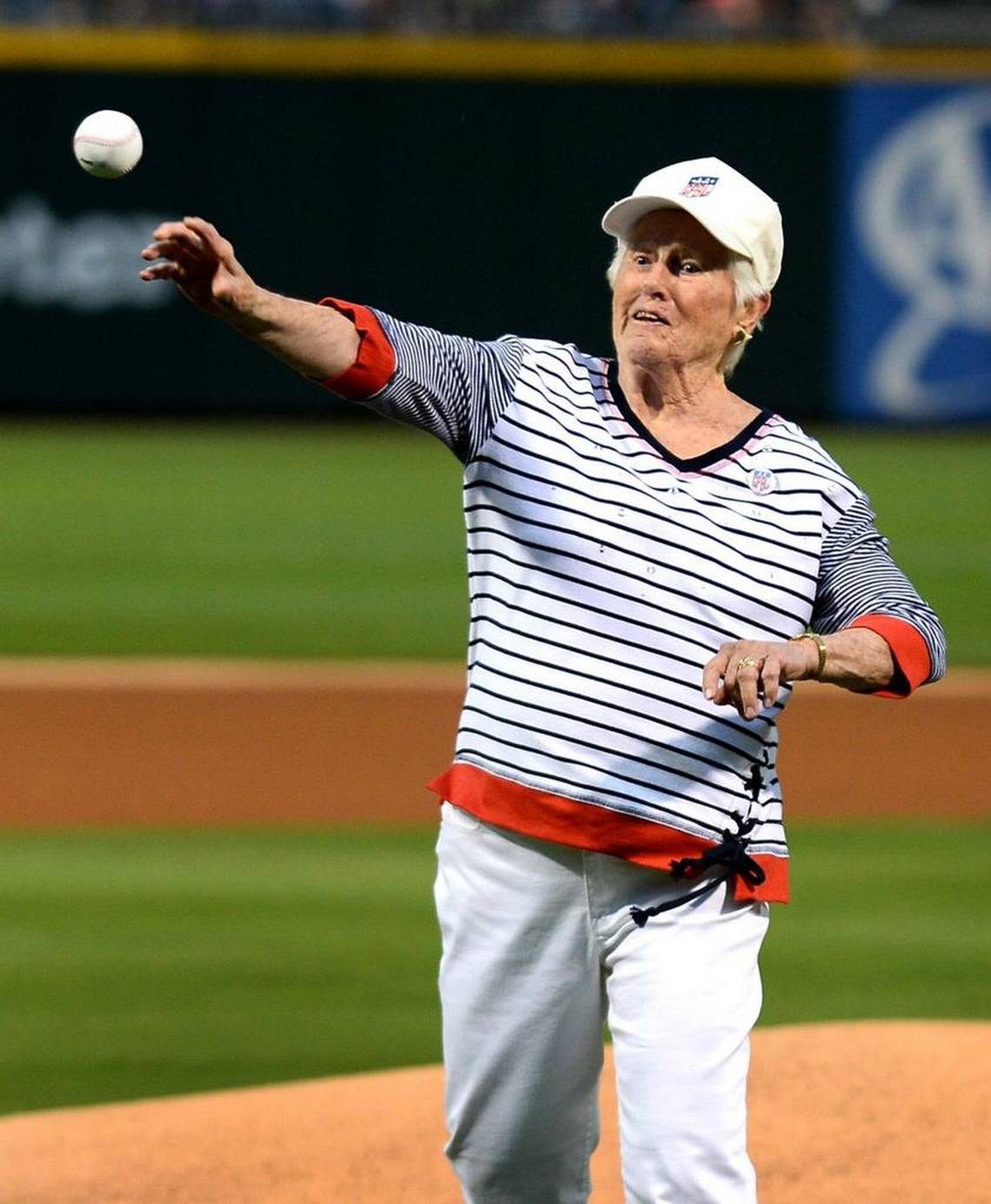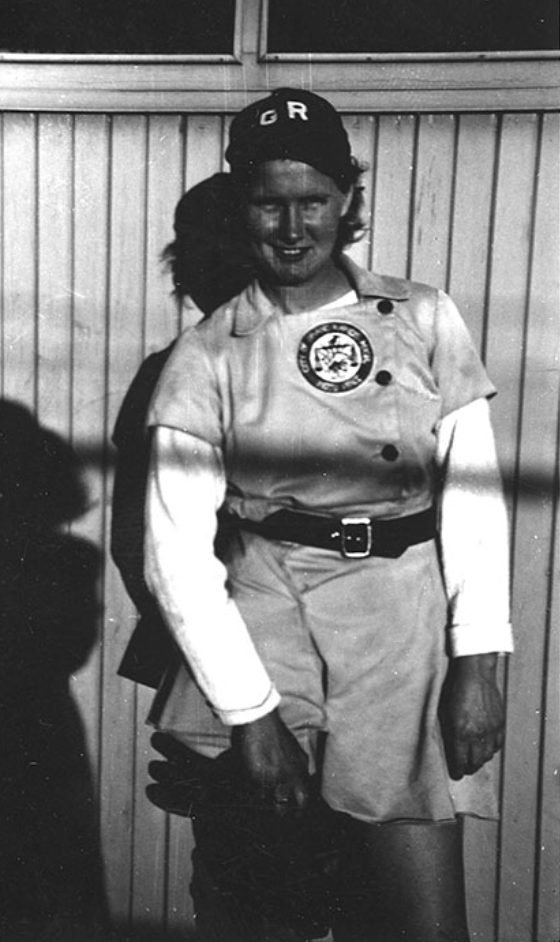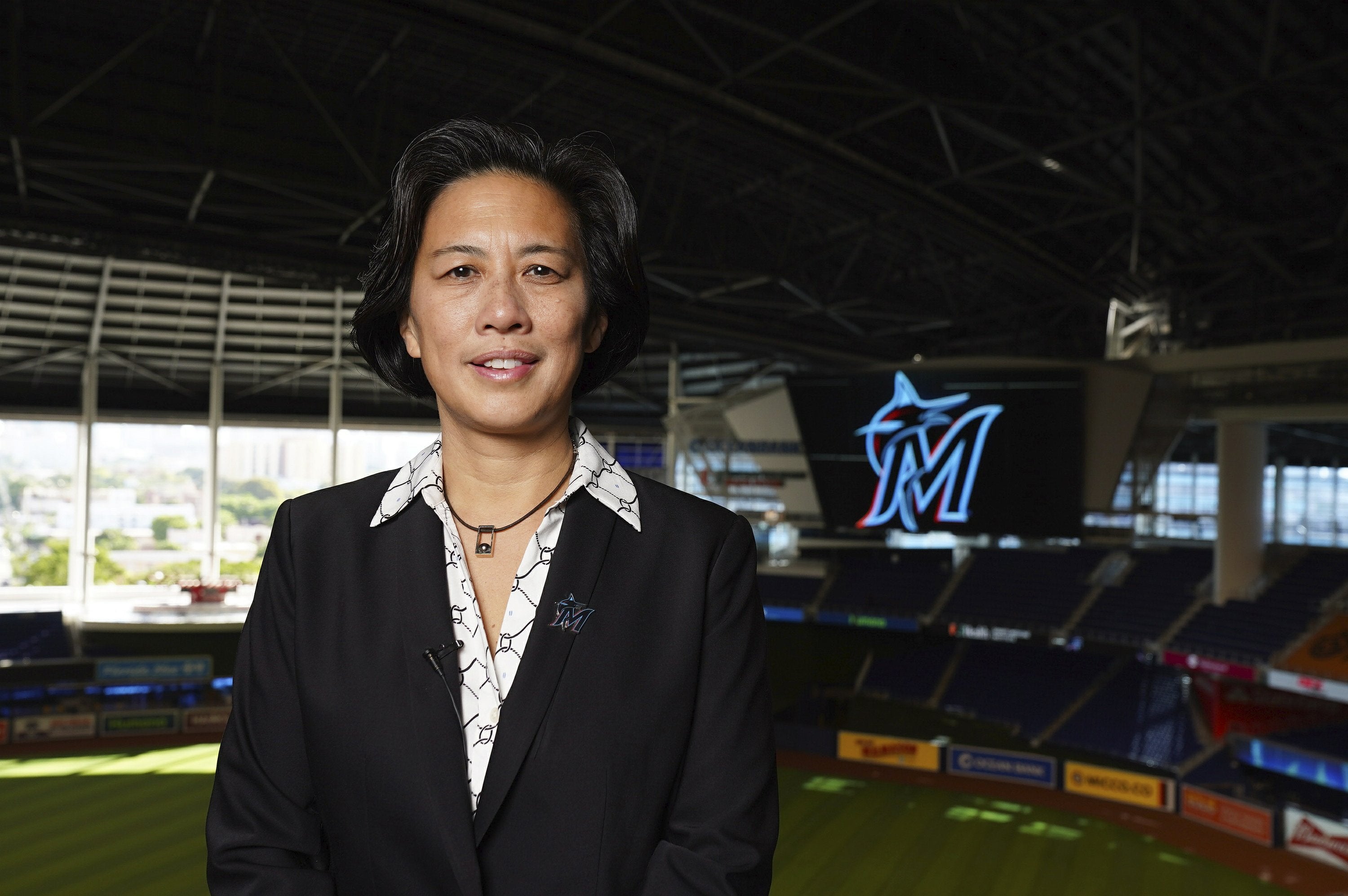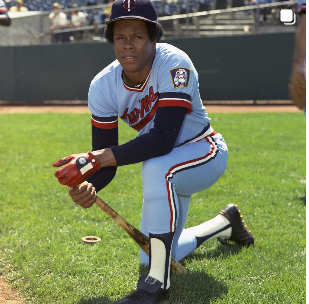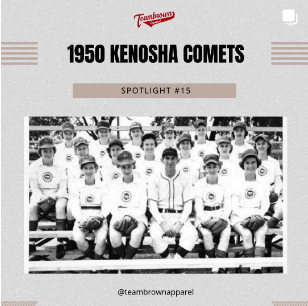This week as part of Women's History Month, we introduce you to some amazing women - today one of the AAGPBL's legends - Jean Faut.
From the AAGPBL website -
Hear about Jean's experience in her own words through the Grand Valley State Oral history project.

Jean was named "Player of the Year" in 1951 and 1953. In 1951 her Pitching Record was 15-7 Earn Run Average 1.33, with 135 Strikeouts, and one Perfect Game. In 1953 her Pitching Record was 17-11,Earn Run Average 1.51 with 143 Strikeouts and one Perfect Game.
Faut, Jean: "League of Her Own: Jean Faut Fondly Remembers Dominant Baseball Career"
Somewhere on a suburban street in East Greenville, Pa., a telephone pole is riddled with rocky indentations looking like bullet holes. Some 75 years later, these marks are now merely relics left by the right arm of the best baseball player the town has ever produced. She was a pitcher who was the most feared and dominant of her generation, and a woman whose baseball career was halted prematurely by the jealousy of her husband. A lifelong athlete who could never fully regain the satisfaction felt during her fleeting moments of athletic greatness.
Jean Faut was a star pitcher for the South Bend Blue Sox of the All-American Girls Professional Baseball League (AAGPBL) and one of the faces of the league from 1946-1953. While many summers have passed since a young Faut roamed the streets of East Greenville with rocks in hand, her memories of those days are as sharp as the curveball that once stymied her opponents.
“Growing up, I lived in a small town and used to stand in the street and throw stones at a telephone pole in order to learn control,” says Faut, who is now 90. "That helped me when I made it to the league because I think it was my biggest asset, along with my curveball.”
The All-American Girls Professional Baseball League was founded by Philip K. Wrigley in 1943 in order to sustain baseball fandom in America during World War II. With many Major League Baseball players fighting overseas in those days, women’s baseball was a lucrative alternative to the men’s game. At its height in 1948, more than 900,000 fans attended the games of the league’s 10 teams. The AAGPBL folded in 1954 amid declining popularity due to reduced publicity and promotional budgets, as well as the emergence of television in the 1950s. “I think television had a lot to do with why our league folded,” says Faut. “People started staying at home and watching TV instead of coming to the ballpark to watch us play. If we had our games televised, I think the league could have survived.”
Faut was an AAGPBL champion in 1951 and ’52, as well as a four-time All-Star with South Bend. She is the league’s all-time leader in ERA with a 1.23 career mark, and second in career wins with 140. A three-time 20-game winner, Faut also tossed two no-hitters and two of the five perfect games in league history. She won two out of the 10 Player of the Year awards given in the history of the AAGPBL, and is one of just two, two-time winners of the award. She is the league’s only Player of the Year who is still living.
“My talent came from God and I loved the game,” says Faut. “And I just had a tremendous team behind me.”
Faut’s humility comes from her humble beginnings in East Greenville. As one of six children growing up in a blue-collar family during the Great Depression, she learned the benefits of hard work from an early age. “My mother grew up in a family that didn’t have much, so she appreciated everything she earned,” says Faut’s oldest son, Larry Winsch. “She was valedictorian of her high school class and played first chair trumpet, in addition to being a track runner and a basketball and field hockey player in high school. She was exceptional at everything she ever did and worked very hard for what she got.”
While Faut never played organized baseball during her youth, her passion for the game surpassed any of her other childhood interests. As a teenager, Faut could often be found at the home of the East Greenville Cubs, a semipro baseball team whose field was two miles from her house. “I was always at their practices shagging fly balls and they realized I had a good arm, so they had me throw batting practice sometimes,” Faut says. “Some of the players taught me the pitches I used in the league.”
During a time when most women were alongside their mothers baking in the kitchen, Faut was basking in the summer sun on a baseball diamond, honing the skills that would one day make her the most revered pitcher in the history of the league. And it wasn’t long before the blonde-haired, blue-eyed spitfire’s knack for pitching attracted the attention of league scouts. A 21-year-old Faut was invited to the AAGPBL’s 1946 spring training in Pascagoula, Miss., before being thrust into South Bend’s starting lineup at the start of the season. As a rookie, Faut played the majority of her first year in the league at third base before moving to pitcher for 12 outings at the end of the ’46 campaign. Faut quickly established herself as the team’s most promising pitcher, displaying signs of the success that was to come by posting a 8-3 record with a 1.32 ERA for the third place Blue Sox.
Faut reported for the 1947 season with a ball in her right hand and a wedding ring on her left. She wed former Phillies pitching prospect Karl Winsch in the offseason and the newlyweds settled in South Bend. Faut finished the ’47 campaign while two months pregnant, and gave birth to the couple’s first of two sons in March 1948. And thus began Faut’s five-year juggling act as mother, wife and baseball star. “After games, I went home and cooked and cleaned for my family like a regular wife would have,” Faut says. “I had a woman hired to take care of my son when I was on the road with the team. But by the time he was three years old, he went with us on the bus, had his own uniform and stayed in the dugout with us during games.”
Despite wearing many hats, Faut managed to put up the best numbers of her career. In 1949, she developed into the most dominant player in the AAGPBL, going 24-8 with a 1.10 ERA, while hitting a league-best .291. Faut followed that with another brilliant season in 1950, when she finished 21-9 with a 1.12 ERA.
While Faut entered the 1951 season in the physical prime of her athletic life, outside influences caused her baseball career to take a sudden turn for the worse. Much to her surprise, Faut’s husband showed up to spring training that year as the new manager of the Blue Sox, after signing with the team in December. “Everything was always hush, hush with him, so I didn’t know he was going to be our new manager until I arrived at spring training,” Faut recalls. “I think my husband was jealous that I was a good pitcher. I think that’s why he applied for the job as manager.”
From Day 1, Winsch was a hard-nosed manager who doled out punishments and suspensions to players he thought demonstrated a lack of hustle or desire. His strict team rules regarding the post-game lives of his players exceeded the already staunch regulations set in place by the AAGPBL. As a result, Faut was often typecast by her teammates as an adversary, who was simply guilty by association.
Amid the awkwardness of being the disliked manager’s wife and the team’s best player, Faut drew into herself and often endured the hardships of times spent mostly in isolation from many of her teammates after games and on the road. “She was in the horrible position of being the manager’s wife,” recounts Larry. “So she really wasn’t a teammate like the rest of the girls. They wouldn’t allow her in because they were afraid that she would report to her husband. My parents had a tempestuous relationship always, so it was a tough time for her.”
But Faut didn’t let her personal life slow her on-field performance, however, as she earned her first Player of the Year award in 1951 after leading South Bend to its first-ever AAGPBL championship. Even more impressive, South Bend clinched the title over perennial-power Rockford with just 12 players on its roster, after six starters left the team midway through the ’51 season due to conflicts with Winsch.
With South Bend improbably repeating as league champions in 1952, Faut missed capturing back-to-back Player of the Year awards by just one vote. But she reclaimed the honor in 1953, when she led the league in wins, strikeouts and ERA on a struggling South Bend team. Despite experiencing tremendous individual successes during that time, Faut reached her personal breaking point at the end of the ’53 campaign, as the situation with her teammates and husband heightened. She announced her retirement from the league just prior to the end of the season. And just like that, at the peak of her playing days, the best pitcher in women’s baseball decided to hang up her cleats and call it quits.
“It was a very uncomfortable situation for me and I decided to retire from baseball to get away from it,” says Faut. “It got to the point where it was affecting our teamwork and we didn’t have the team spirit we should have had. We could have done a whole lot more as a team that year if that situation hadn’t been there, but I was stuck in the middle, so I just bowed out.”While the 1954 season proved to be the last for the AAGPBL, Faut was left for decades to wonder what might have been had she stuck it out with the Blue Sox for just one more year. “I’m extremely unhappy about the fact that I didn’t play in 1954,” says Faut. “Some of the players said to me that if I had played, the team would have won the league in its last year. I never forgot that because I know I could have played another year.”
To replace the gaping void in her life left by baseball, Faut consumed herself with her family and a secretarial job in South Bend after her retirement from the league. She gave birth to her second son, Kevin, in 1957, and divorced Winsch in 1968. Faut then married salesman Charles Eastman in 1977 and relocated to Rock Hill, South Carolina with her two sons, where they all still reside today. And while her athletic life didn’t end when her baseball career did—as she pursued professional bowling for 30 years and recreational golf into her '70s—nothing ever quite compared to her time in the AAGPBL, when baseball was king to her and she was the queen of diamonds.

“Those were the best years of her life, so when it was taken away, it was very hard for her,” Larry says. “She was in a very competitive environment and had a situation where she had people cheering for her on a daily basis and it was addictive. It was something she couldn’t ever replicate.”
But what Faut could replicate was the feeling of pride for having been the most successful pitcher in the league’s history. She and other members of the AAGPBL were honored with an exhibit in the Baseball Hall of Fame in 1988, and each year in a different city throughout the country, a reunion takes place for the league’s players and their families. At the annual event, Faut is reminded of her great feats, which not only left indelible marks on the historic league, but also on her family.
“Every time I go to the banquet for the league, many of the people who speak at the podium mention her, so that’s how I know she made quite an impression on a lot of people,” Faut’s son Kevin says. “She was really something special in that time. I’m so proud, and I know my kids and grandkids are too, that she played and is considered the best pitcher in the league’s history,” says Larry. “It will always mean a lot to our family.”
And while her last strikeout was recorded more than 60 years ago, Faut’s love for baseball—and competition—is still just as fervent as it was during her rock-throwing days in East Greenville. She is an avid follower of the Atlanta Braves and cites Freddie Freeman as her favorite player since Chipper Jones’ retirement in 2012. Now a grandmother of four and great-grandmother of three, Faut still tosses the baseball around with her family members whenever she has the chance.
“We had a church softball game a couple of months ago and she was out there rooting everybody on from the stands,” says Kevin. “She couldn’t be on the field playing at her age, of course, but after watching for a while, she wanted to throw the ball around. So, she and my son played catch on the side of the field. Everyone enjoyed watching her. She was throwing the ball pretty well.”
Author: Kayla Lombardo Contributed By: Larry Winsch Copyright: Sports Illustrated 7/14/2015
#HistoryInYourSize




